What You Need to Know About Motor Liability Coverage
Motor liability coverage is also known as the Third Party Liability Insurance and it covers only the vehicle that you drive. This coverage does not extend to your own vehicle meaning the expenses of repairing your own vehicle or replacing its parts will come out of your pocket. Liability coverage kicks in when you have an accidental collision with another vehicle. Liability Insurance will only cover the costs of repairs to the vehicle(s) you hit.
Liability coverage is the most basic type of coverage for all types of motor vehicles. In fact, it is a typical requirement that motorists are obligated to purchase annually. This is usually renewed annually along with the renewal of the driver’s license and car registration with the DMV or the Department of Motor Vehicles. It does not matter if you opt not to purchase liability coverage, once you hit another vehicle, you are liable for the repair or parts replacement costs resulting from the collision. Your costs could run up especially if the parts that need replacing are quite expensive. So anybody who owns a vehicle should not fail to purchase a liability coverage insurance.
Oftentimes people feel they do not need this insurance perhaps because their car is not expensive to maintain and repair. They soon find out that during an accident, sometimes the vehicle they hit is more expensive than what they are driving. They also realize that the debt they will owe for the accident can be quite exorbitant and they do not have the ready cash to settle it, so they would need to take out a loan leaving them in debt. Motor liability insurance has a very low premium, clearly a small price to pay to protect you from prohibitive financial obligations in the future.
The bulk of third party claims are due to vehicles that suddenly stop without warning in front of a moving vehicle. In this situation, the vehicle that drives into the stalled vehicle is still held partly liable. When accidents are due to both party’s negligence or fault, the damages will be assessed and apportioned based on the degree of fault.
You can augment your liability insurance with other motor vehicle or car insurance coverage. One type of insurance that is popular, particularly for new vehicles, is the comprehensive car insurance. This type of coverage pays for damages caused by the driver to his own vehicle. You can also insure your car against theft, fire, or flood.
Motor insurance in the United States and in other countries have been designed to provide vehicle owners or drivers coverage against the risk of liability should the driver of the vehicle figure in an accidental collision that may result to vehicle damage and even physical injuries. The insured typically has to pay their insurer a monthly insurance premium although most of the time, liability coverage premium is paid on an annual basis. The premium for liability coverage is typically a flat rate, but if the vehicle owner would opt for a comprehensive coverage, there are factors considered before a premium is set. Insurance companies would typically look into the model and make of the vehicle, the drivers of the vehicle, the history of their driving, and the place where the vehicle is driven.
The insured would receive an insurance certificate or a card indicating the coverage details of their vehicle insurance. This certificate must be kept inside the vehicle at all times as it is used as a proof of insurance. There are some states that allow an electronic version of this proof of insurance. Automotive liability coverage protects vehicle owners and usually the other people driving the insured vehicle. Those living with the vehicle owner must be covered on the insurance policy. For instance, it is a must to name a young adult reaching the driving age into the policy.
Liability insurance typically would not cover the policy holder if they are driving a different vehicle than the one insured. For this situation, one can purchase a non-owners insurance policy. This type of coverage provides protection or a person who figures in a vehicle accident driving a car that is not their own.

